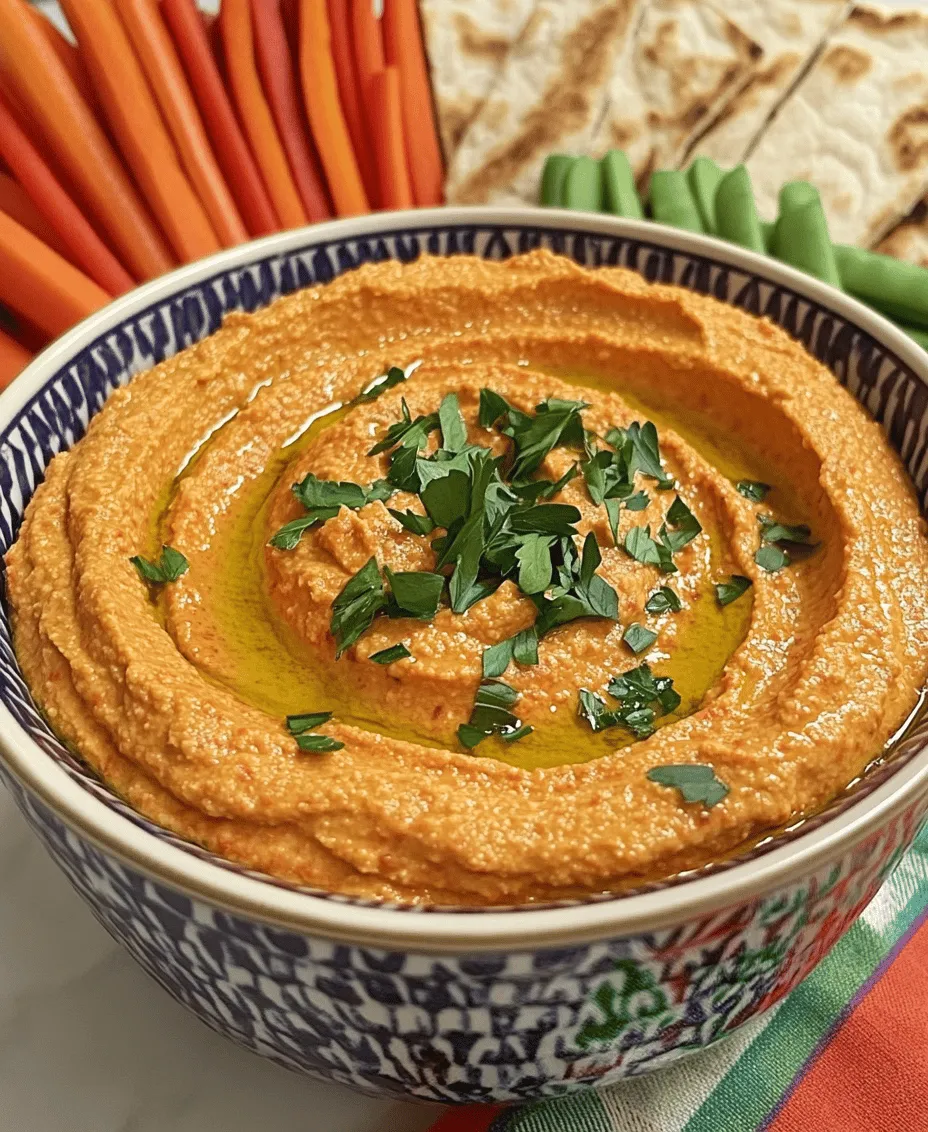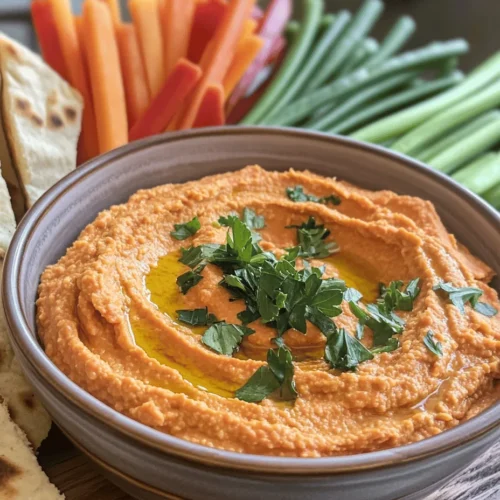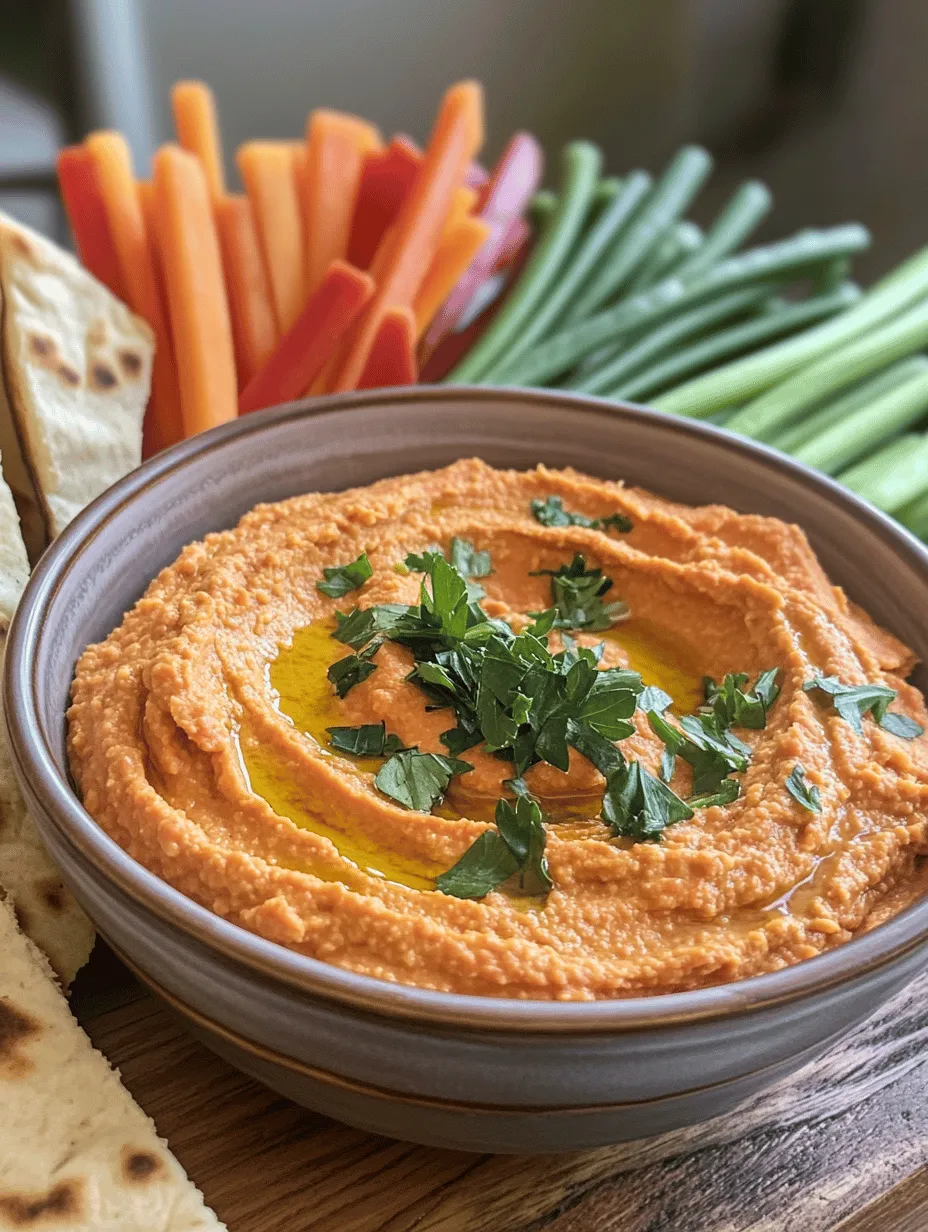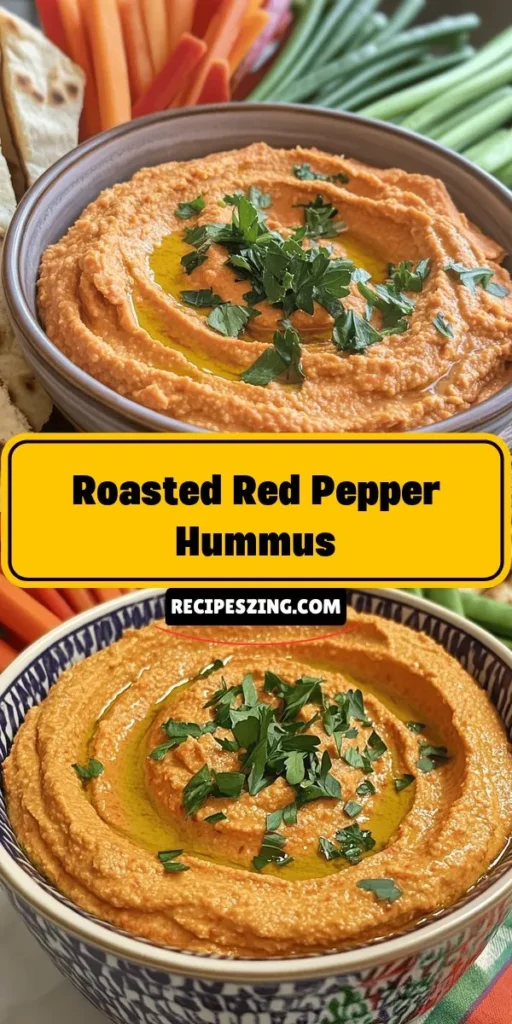Introduction
Hummus, a beloved Middle Eastern dip, has gained immense popularity worldwide for its creamy texture and rich flavor. Traditionally made from blended chickpeas, tahini, olive oil, lemon juice, and garlic, this versatile spread is a staple in Mediterranean cuisine. But within the vast realm of hummus varieties, one stands out for its vibrant color and smoky flavor: roasted red pepper hummus. This delightful twist on the classic recipe introduces roasted red peppers into the mix, enhancing the dip’s flavor profile and making it an irresistible addition to any meal or snack.
Homemade hummus not only offers superior taste compared to store-bought versions but also allows you to control the ingredients, making it a healthier option. By preparing your hummus from scratch, you can avoid preservatives and additives, ensuring that every bite is packed with wholesome goodness. In this article, we will take a deep dive into the world of roasted red pepper hummus, exploring its nutritional benefits, cultural significance, and providing a step-by-step guide to creating this delectable dish right in your kitchen.
The Appeal of Roasted Red Pepper Hummus
Nutritional Benefits of Chickpeas and Roasted Red Peppers
Chickpeas, the primary ingredient in hummus, are not only delicious but also incredibly nutritious. They are a great source of plant-based protein, making them an excellent choice for vegetarians and vegans. Rich in fiber, chickpeas can aid digestion and help maintain a healthy weight. They also contain essential vitamins and minerals, including folate, iron, and magnesium, which contribute to overall health and well-being.
Roasted red peppers, on the other hand, bring their unique health benefits to the table. They are low in calories and high in vitamins A and C, both of which are powerful antioxidants. These nutrients support immune function, skin health, and eye health. Moreover, the roasting process enhances the natural sweetness of red peppers, adding a delightful depth of flavor to the hummus without the need for added sugars.
Versatility of Hummus in Various Diets
One of the most appealing aspects of hummus is its versatility. Roasted red pepper hummus is suitable for various dietary preferences, including vegan and gluten-free diets. It can be enjoyed as a dip for fresh vegetables, spread on sandwiches, or used as a flavorful base for grain bowls. This adaptability makes it a fantastic addition to any meal, whether you are hosting a gathering or simply looking for a healthy snack.
The Cultural Significance of Hummus in Mediterranean Cuisine
Hummus has deep roots in Mediterranean and Middle Eastern cultures, where it has been enjoyed for centuries. It is more than just a food item; it represents hospitality and community, often served at gatherings and celebrations. The act of dipping bread or vegetables into hummus fosters a sense of togetherness, making it a cherished dish across various cultures. By making roasted red pepper hummus at home, you not only create a delicious snack but also connect with the rich culinary traditions of the Mediterranean.
Ingredients Breakdown
Creating the perfect roasted red pepper hummus requires a careful selection of ingredients. Each component contributes to the overall flavor, texture, and nutritional profile of the dish. Below is a detailed description of each ingredient you will need to make this delightful hummus.
Chickpeas
The foundation of hummus, chickpeas (also known as garbanzo beans), are packed with nutrients. One cup of cooked chickpeas contains about 15 grams of protein and 12 grams of fiber, making them an excellent choice for sustaining energy levels and promoting fullness. They are also a good source of complex carbohydrates, which provide lasting energy.
Roasted Red Bell Pepper
Roasted red peppers add a unique flavor enhancement to hummus. Their natural sweetness and smokiness elevate the dip, creating a delicious contrast to the earthiness of the chickpeas. To roast red bell peppers, you can use methods such as grilling or broiling, which will be discussed in detail later in this article. The roasting process caramelizes the sugars in the peppers, resulting in a deeper, more complex flavor.
Tahini
Tahini, a paste made from ground sesame seeds, is a key ingredient in traditional hummus. It contributes to the creamy texture and nutty flavor of the dip. Additionally, tahini is rich in healthy fats, protein, and essential minerals, such as calcium and iron. When selecting tahini, look for brands that use whole sesame seeds for the best flavor and nutritional profile.
Olive Oil
Olive oil is known for its numerous health benefits, including heart-healthy monounsaturated fats and antioxidants. In hummus, olive oil adds richness and depth, enhancing the overall flavor. Use high-quality extra virgin olive oil for the best taste and nutritional benefits. You can also drizzle some on top of your finished hummus for added flavor and presentation.
Garlic
Garlic is a staple ingredient in many cuisines, including Mediterranean dishes. It adds a punch of flavor to hummus and is also known for its numerous health benefits, including anti-inflammatory and immune-boosting properties. Fresh garlic cloves are recommended for the best taste, but you can adjust the amount according to your preference.
Lemon Juice
Fresh lemon juice brings brightness and acidity to roasted red pepper hummus, balancing the richness of the chickpeas and tahini. The citric acid in lemon juice also enhances the flavors of the other ingredients, making your hummus taste fresher. Additionally, lemon juice is a good source of vitamin C, which supports immune health.
Ground Cumin
Ground cumin adds a warm, earthy flavor to hummus, giving it a distinctive taste that pairs well with the other ingredients. This spice is commonly used in Middle Eastern cuisine and enhances the overall depth of the dip. If you don’t have ground cumin, you can use whole cumin seeds, but be sure to toast them first for maximum flavor.
Salt
Salt is essential for enhancing flavor in all dishes, including hummus. A small amount of salt can make a significant difference in bringing out the natural flavors of the other ingredients. Start with a pinch and adjust according to your taste preferences.
Water
Water is used to adjust the consistency of your hummus. Depending on how thick or creamy you want your dip to be, you can add water gradually until you reach your desired texture. This flexibility allows you to customize your hummus to your liking.
Fresh Parsley
Fresh parsley not only adds a pop of color to your hummus but also contributes a fresh, herbal flavor. It can be used as a garnish or blended into the hummus for an added layer of taste. Parsley is also rich in vitamins and antioxidants, making it a healthy addition to your dish.
Serving Options: Pita Bread and Veggie Sticks
Roasted red pepper hummus is perfect for sharing and can be served with various accompaniments. Pita bread, whether toasted or warmed, is a classic pairing, complementing the creamy texture of the hummus. Fresh vegetable sticks, such as carrots, cucumber, and bell peppers, provide a crunchy contrast and are an excellent way to enjoy this dip in a healthy manner. You can also use roasted or grilled meats as a flavorful addition to your hummus spread.
Preparation of Roasted Red Pepper Hummus
Now that you have a thorough understanding of the ingredients, it’s time to dive into the preparation of roasted red pepper hummus. This section will guide you through the process, beginning with roasting the red bell peppers.
Step-by-Step Guide to Roasting Red Bell Peppers
Roasting red bell peppers is a simple yet vital step in creating roasted red pepper hummus. The roasting process enhances the natural sweetness and flavor of the peppers, making your hummus even more delicious. Here are two popular methods for roasting red bell peppers:
Grilling
1. Preheat the Grill: Begin by preheating your grill to medium-high heat.
2. Prepare the Peppers: Wash and dry the red bell peppers. You can leave them whole or cut them in half, removing the seeds and stems.
3. Place on the Grill: Place the peppers on the grill grates, cut side down if halved. Grill for about 6-8 minutes, turning occasionally until the skin is charred and blistered.
4. Steam and Peel: Once roasted, transfer the peppers to a bowl and cover it with plastic wrap or a lid. Allow them to steam for about 10-15 minutes. This helps loosen the skin for easier peeling.
5. Peel and Set Aside: After steaming, peel off the charred skin, and your roasted red peppers are ready to be used in the hummus.
Broiling
1. Preheat the Broiler: Preheat your oven’s broiler to high.
2. Prepare the Peppers: As with the grilling method, wash and dry the red bell peppers. Cut them in half to remove seeds and stems.
3. Broil the Peppers: Place the halved peppers on a baking sheet, cut side down. Broil for about 10-15 minutes or until the skin is charred and blistered.
4. Steam and Peel: Transfer the roasted peppers to a bowl, cover, and let them steam for 10-15 minutes.
5. Peel and Set Aside: After steaming, peel off the skin, and your roasted red peppers are ready to enhance your hummus.
Comprehensive Blending Instructions
With the roasted red peppers ready, it’s time to blend the ingredients together to create your hummus.
1. Gather Your Ingredients: In addition to the roasted red peppers, have your chickpeas, tahini, olive oil, garlic, lemon juice, ground cumin, salt, and water ready.
2. Combine Ingredients in a Food Processor: In a food processor, add the roasted red peppers, drained chickpeas, tahini, olive oil, garlic, lemon juice, ground cumin, and salt.
3. Blend to Combine: Pulse the mixture a few times to start breaking down the ingredients. This initial blending helps integrate the flavors.
4. Adjust Consistency: With the food processor running, gradually add water, one tablespoon at a time, until you reach your desired consistency. For a creamier texture, you may need to add more water.
5. Blend Until Smooth: Continue blending until the hummus is smooth and creamy. Stop to scrape down the sides of the bowl if necessary to ensure everything is well mixed.
6. Taste and Adjust: Taste your hummus and adjust seasoning as needed. You can add more salt, lemon juice, or garlic to suit your palate.
Adjusting Consistency for Personal Preference
The beauty of hummus lies in its versatility, particularly when it comes to texture. Some people prefer a thicker hummus, while others enjoy a creamier dip. Here are some tips on achieving the perfect consistency:
– Thicker Hummus: If you prefer a thicker hummus, reduce the amount of water you add during blending. You can also use less olive oil or tahini, as these ingredients contribute to the creaminess.
– Creamier Hummus: For a creamier texture, add more water gradually, but be cautious not to overdo it. Another trick is to use a bit of aquafaba (the liquid from the chickpeas) instead of plain water, which enhances the flavor and creaminess.
Now that you have the foundational knowledge and preparation steps for creating roasted red pepper hummus, you are well on your way to crafting a delicious and healthful dip that can be enjoyed in numerous ways. This homemade hummus is a nutritious snack, a party favorite, and a versatile addition to your culinary repertoire. As you prepare to make this delightful dish, remember to savor the process and enjoy the aromatic flavors that will fill your kitchen.

Balancing Thickness with Water Incrementally
When it comes to achieving that perfect creamy texture for your roasted red pepper hummus, the key lies in the water. After blending your initial ingredients, you may find the hummus to be thicker than desired. To remedy this, add water incrementally. Start with a tablespoon of water, blend, and assess the consistency. Repeat this process until you reach your preferred thickness. This method not only helps avoid over-dilution but also allows you to maintain control over the final texture of your hummus. Remember, the aim is to create a smooth, spreadable concoction that still holds its shape when served.
Taste Testing and Flavor Adjustments
Tasting your hummus throughout the preparation process is essential for achieving the ideal balance of flavors. It’s a great way to ensure that your hummus is tailored to your personal palate.
Importance of Tasting During the Cooking Process
As you blend your ingredients, take the time to taste the mixture. This step is crucial, as flavors can change once the hummus is fully blended. Not only does this help you achieve the right balance of taste, but it also allows you to make adjustments before serving.
How to Adjust Flavors
– Adding More Salt: If your hummus tastes flat or bland, a pinch of salt can elevate the flavors significantly. Start with a small amount and taste again before adding more.
– Lemon Juice: A splash of fresh lemon juice can brighten the overall flavor profile. If your hummus is tasting a bit heavy, the acidity from the lemon will counterbalance it beautifully.
– Garlic: If you want a bolder garlic flavor, consider adding an extra clove. Roasted garlic can also be used for a sweeter, more mellow touch.
– Experimenting with Spices: Don’t hesitate to incorporate spices like cumin, paprika, or cayenne pepper to further enhance the flavor. Each addition can bring a unique twist to your hummus.
Common Mistakes to Avoid When Making Hummus
While preparing hummus is fairly straightforward, there are a few common pitfalls to avoid:
1. Over-processing: Blending for too long can lead to a gummy texture. Aim for a creamy consistency but stop blending as soon as you achieve smoothness.
2. Insufficient seasoning: Hummus can often taste bland if not seasoned properly. Always taste and adjust your seasonings as needed.
3. Skipping the tahini: Tahini is essential for that classic hummus taste and creaminess. Don’t omit this ingredient, as it’s what gives hummus its unique flavor.
Serving Suggestions
Roasted red pepper hummus is incredibly versatile and can be served in a myriad of delicious ways. Here are some creative serving suggestions:
As a Dip with Pita and Vegetables
The most popular way to enjoy hummus is as a dip. Serve your roasted red pepper hummus alongside warm pita bread, crunchy vegetable sticks (like carrots, cucumber, and bell peppers), or even tortilla chips. This combination makes for a fantastic appetizer or snack.
Spread on Sandwiches and Wraps
Give your sandwiches and wraps a flavor boost by spreading a generous layer of hummus. It works beautifully with grilled vegetables, turkey, or falafel, adding both moisture and flavor without the need for mayonnaise or other spreads.
Incorporating into Salads or Grain Bowls
Roasted red pepper hummus can also be used as a dressing or topping for salads and grain bowls. A dollop of hummus adds creaminess and flavor to your greens, quinoa, or bulgur, making it a nutritious and satisfying meal.
Presentation Tips for an Appealing Serving Style
When serving hummus, presentation is key. Consider the following tips to make your dish visually appealing:
– Use a wide, shallow bowl to showcase the hummus.
– Create a small well in the center to drizzle olive oil or add a few roasted red pepper pieces for garnish.
– Sprinkle fresh herbs (like parsley or cilantro) or spices (like paprika) on top for added color.
Pairing Suggestions: Wines, Drinks, or Side Dishes
To complement your roasted red pepper hummus, consider pairing it with:
– Wines: A crisp Sauvignon Blanc or a light Pinot Grigio pairs well with the flavors of the hummus.
– Drinks: Refreshing beverages like sparkling water with lemon or herbal iced tea can cleanse the palate and enhance the dining experience.
– Side Dishes: Serve with a side of stuffed grape leaves, olives, or a Mediterranean salad to create a complete meal.
Storing and Preserving Hummus
Homemade hummus is not only delicious but also easy to store, making it a fantastic addition to your meal prep routine.
Best Practices for Storing Homemade Hummus
To keep your hummus fresh, transfer it to an airtight container. Make sure to press a piece of plastic wrap directly onto the surface of the hummus before sealing the container to minimize air exposure. This step helps prevent the formation of a dry crust.
How Long Roasted Red Pepper Hummus Lasts in the Fridge
When stored properly in the refrigerator, roasted red pepper hummus can last for about 4 to 7 days. Always check for any signs of spoilage before consuming, such as off smells or visible mold.
Freezing Hummus for Long-Term Storage: Techniques and Tips
For long-term storage, hummus can be frozen. Here’s how to do it:
1. Portioning: Divide your hummus into smaller portions using ice cube trays or muffin tins. Once frozen, transfer the portions into a zip-lock bag or an airtight container.
2. Labeling: Don’t forget to label the bags with the date so you can keep track of freshness.
3. Thawing: When ready to use, simply thaw the desired portion in the refrigerator overnight or give it a quick defrost in the microwave. You may need to stir in a little water or olive oil after thawing to restore its creamy texture.
Health Benefits of Hummus
Roasted red pepper hummus is not just tasty; it’s also packed with health benefits.
Overview of Chickpeas as a Superfood
Chickpeas, the primary ingredient in hummus, are a nutritional powerhouse. They are high in protein and fiber, making them an excellent option for vegetarians and vegans. Additionally, chickpeas can help regulate blood sugar levels and promote digestive health.
Benefits of Healthy Fats from Olive Oil and Tahini
The use of olive oil and tahini in hummus provides healthy fats, which are essential for a balanced diet. Olive oil is rich in monounsaturated fats, which can reduce the risk of heart disease, while tahini offers calcium, iron, and other vital nutrients.
The Role of Hummus in a Balanced Diet
Incorporating hummus into your diet can help you meet your daily intake of legumes and healthy fats. It can serve as a nutritious snack, a tasty spread, or a flavorful addition to meals, enhancing both flavor and nutrition.
Exploring Hummus as a Healthy Snack Alternative
With its wholesome ingredients, hummus makes for an excellent snack option. Pair it with vegetables or whole-grain crackers for a satisfying and health-conscious treat that keeps energy levels stable.
Cultural Variations of Hummus
Hummus has gained popularity worldwide, leading to a variety of regional adaptations.
Overview of Different Hummus Variations Around the World
While roasted red pepper hummus is a delightful twist, traditional hummus is often made with just chickpeas, tahini, lemon juice, garlic, and olive oil. Other variations may include ingredients like beetroot, spinach, or even avocado, each bringing its unique flavor and color.
Popular Ingredients Used in Other Regional Recipes
In the Middle East, it’s common to find hummus topped with pine nuts or drizzled with spiced olive oil. In Mediterranean regions, you might encounter versions that incorporate herbs like dill or mint for a refreshing twist.
How Roasted Red Pepper Hummus Fits into the Broader Hummus Landscape
Roasted red pepper hummus stands out in this diverse landscape for its smoky, sweet flavor profile, making it a favorite among hummus enthusiasts. Its unique taste elevates traditional hummus while still maintaining the essence of this beloved dish.
Conclusion
In summary, making roasted red pepper hummus is a straightforward process that yields a flavorful and nutritious dip that can be enjoyed in countless ways. From its simple ingredient list to its versatile serving options, this hummus is a must-try for anyone looking to add a healthy spin to their meals.
Embrace the joy of creating homemade hummus, and allow it to become a staple in your healthy eating routine. Whether enjoyed with friends at a gathering or savored solo as a snack, roasted red pepper hummus is sure to delight your taste buds and nourish your body. So gather your ingredients, get blending, and relish in the satisfaction of sharing this delicious treat with those you love.



